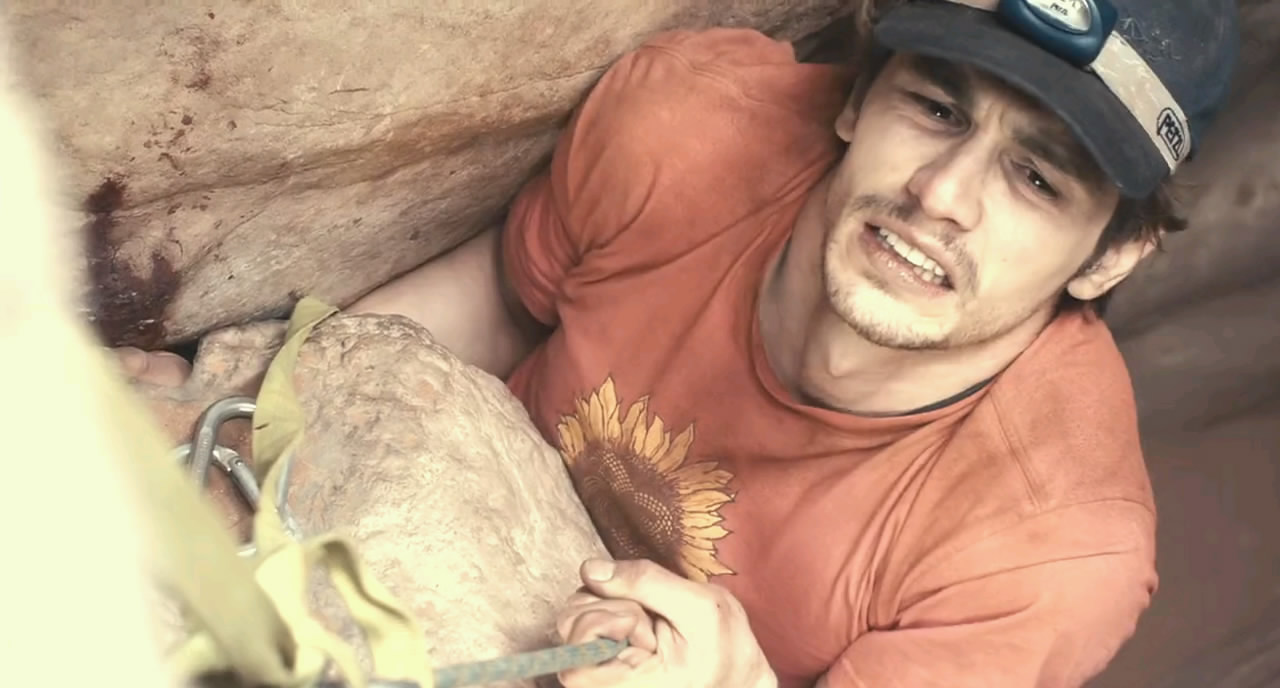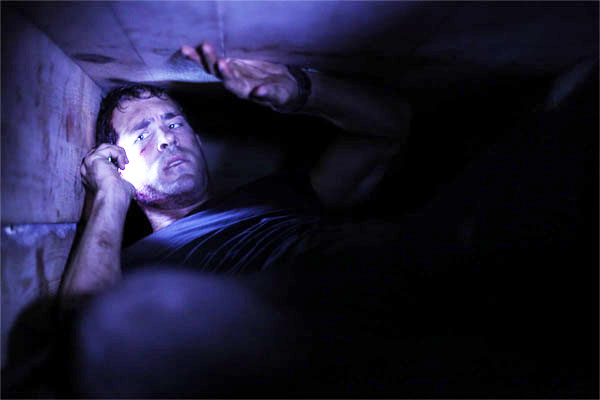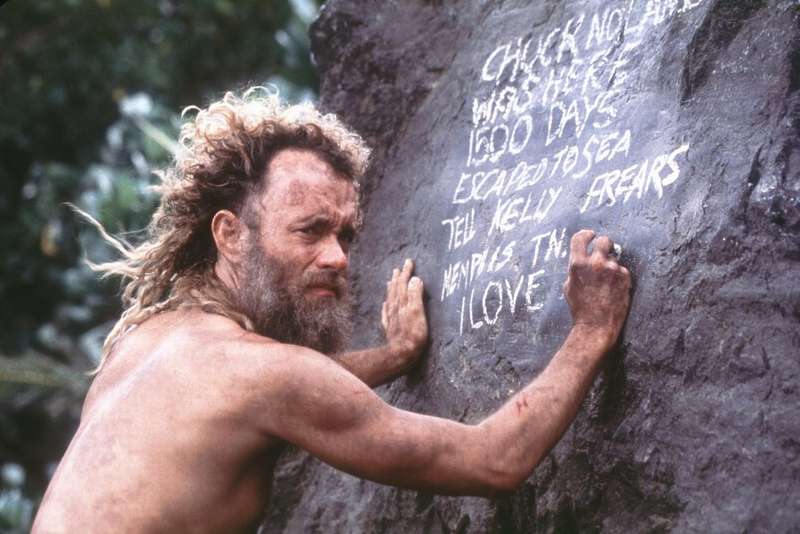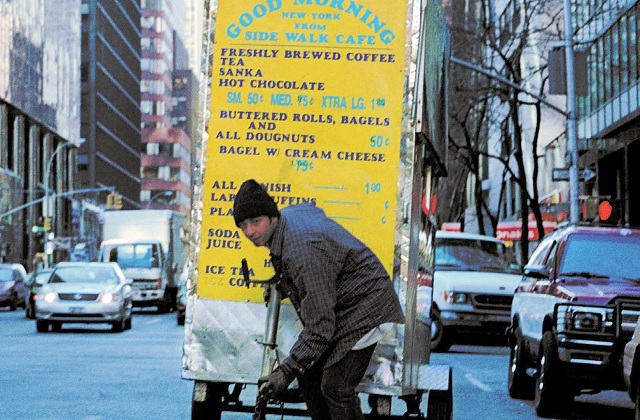5. 127 Hours (2010)

Danny Boyle’s biographical survival drama is based on the real life story of Aron Ralston’s ill-fated trip to the chasm of an isolated slot canyon in Blue John Canyon, south eastern Utah and more specifically from his memoir “Between a Rock and a Hard Place”. Set in April, 2003 – It follows adventurer Ralston (James Franco) as he hikes through a slot canyon.
While climbing down it, he accidentally slips and falls. A boulder pins his arm against the canyon wall and he is stuck. His several attempts at removing the boulder and calling for help are to no avail. He begins recording a video diary on his camera (so as to keep a running dialogue with the audience) and rations his food and water. He then starts using his pocket knife to carve away parts of the boulder so as to unlock his arm.
While there are some other characters in this film, like a couple of hikers (Kate Mara and Amber Tamblyn) he briefly meets, and flashbacks to his sister (Lizzy Caplan) and his girlfriend (Clémence Poésy), the majority of the film is just Franco.127 Hours was well received by critics and audiences, and was nominated for six Academy Awards, including Best Actor for Franco and Best Picture.
4. Buried (2010)

The plot of Rodrigo thriller is brilliantly simplistic – one coffin, one man stuck inside and a fistful of items which could save his life if his air doesn’t run out first. The main problem with this basic plot would be the feature length – it would make a great short film – but Rodrigo Cortés’ talent is showcased through the 95 minute running time which never ceases to let go of the audiences’ attention. The movie begins and ends inside a coffin, and no one besides the dedicated Ryan Reynolds shows up onscreen.
Paul Conroy is a truck driver working for a private contractor in Iraq. After his truck was ambushed, he wakes up in complete blackness, stuck inside a coffin. He finds a cell phone and realizes that he has been kidnapped and is a hostage. His captors want him to use the phone, to make a video, to contact the embassy and demand ransom.
The cell phone allows him to speak to other characters besides his captors, most of whom are out, busy or pass him along to another person who he has to re-explain his entire situation again and again, wasting his breath – literally. The calls are ridiculously frustrating as he has to shuffle through the bureaucratic necessities, being put on hold and listen to voice mail messages.
There are no shots of the people answering the phone or any flashbacks – the only person the audience truly knows is Paul, as we witness his private hell as no one else seems to fully comprehend the urgency.
Cortés’ utilisation of various kinds of light dictates the frustration, the immediacy and the fear of the situation. Paul manages to see through constantly draining sources like his oxygen competitor zippo, the cellophane screen, a couple of green glow sticks and a torch that barely works.
One minute he’s shouting, screaming for help in an intense close-up – his face lit by fire, the next he is trying to control himself and think logically with the cool blue glaze of his cellphone screen – trying to collect his thoughts and act kind to whoever he is speaking despite his impending death. Ryan Reynolds has limited space to work in, but makes his character convincing and so holds up this movie.
3. Cast Away (2000)

Now, there are many other actors besides Tom Hanks within Cast Away, but the film has landed its place on to the list since he is alone for approximately two-thirds of its running time, and the additional characters hardly contribute to the plot. Hanks plays time-obsessed FedEx executive Chuck Noland, who flies all over the world and fixes everybody’s problems.
Noland hitches a ride on a FedEx flight across the Pacific, which is blown off course before crashing after an on-board explosion. Noland is the only one who survives the crash, and floats on a life raft to a deserted, unknown island.
Alone and stranded, the clock-ran man slows down and finds himself suspended in time where his future barely exists and all notion of time is lost. Chuck splits coconuts, traps fish, builds fires, and tries to utilise the contents of washed-up FedEx boxes in order to survive. He finds a volleyball and paints a face on a volleyball and names it Wilson – a genius plot device which gives the movie a reason to include dialogue segments and to illustrate Chuck’s alienation and need for companionship.
The film was not shot consecutively. Hanks gained 50 pounds (23 kg) during pre-production to make him look like a pudgy, middle-aged man and after the majority of the film was shot, production went on a yearlong hiatus so that Hanks could lose the weight, grow his hair and beard and so Zemeckis could make another film, “What Lies Beneath”.
2. Man Push Cart (2006)

The film follows Ahmad (Ahmad Razui) as he earns his living by pushing his stainless steel wagon down the lonely Manhattan streets and selling bagels, cigarettes, snacks and coffee to his loyal customers. He once was a Pakistani rock star, but now his life revolves around his pushcart.
Not much is said about why he came to America and what happened to his music career, but it is revealed that his wife died and that his in-laws will not allow him to see his son. His life is fuelled by his need to make a living. He is too busy and exhausted for anything else. The simplicity of the story is refreshing and moving. It focuses on hard work and daily struggles and does not try to become some melodramatic tale of him trying to regain what was lost.
The writer-director Ramin Bahrani shot his low-budget debut film on the streets of Manhattan in less than three weeks. He often used a concealed camera and managed to capture the spontaneity of the city. His film was accepted into Sundance and captured Roger Ebert’s attention and was on his list for top 10 films of 2006 and the two struck up a friendship.
Bahrani was inspired by “The Myth of Sisyphus,” by Albert Camus, the story of a man who spends his life pushing a rock up a hill, only to see it roll down again, and only push it back up again.
1. Moon (2009)

In the not so distant future, the Earth’s pollution crisis is solved by Helium-3, which provides Earth with pollution-free power from nuclear fusion. It is extracted and processed from lunar rock by automated minors overseen and maintained by one crew member who is stationed alone in the Moon for a three year period.
The film follows this single crew member, Sam Bell (Sam Rockwell) in the final days of his three year contract. The only companionship he has is Gerty (voiced by Kevin Spacey), a well-mannered robot companion similar to 2001’s HAL 9000 and delayed video messages from his wife back home.
Besides Spacey’s voice, a couple of hallucinations and some video footage of his wife, Rockwell acts alone. He carries the film with his intense individualistic dialogues and his confusion as he slowly cracks from the loneliness and seclusion of the last three years. A carefully crafted sci-fi yarn that hints at Lunar Industries’ authoritarian control, there are also thematic and visual references to 2001: A Space Odyssey and Silent Running.
Alone in space, Sam’s actions and need for communication are low on Lunar Industries’ list of concerns. Indifferent to his struggles, the cold place and intensely grim realisations of the truth are dramatized and heightened by Clint Mansell’s solidly suspenseful score.
Duncan Jones’ directorial debut amazed critics and audiences alike. The science fiction drama was modestly budgeted at approximately $5 million, and made roughly double that worldwide. Released at Sundance, the film garnered nominations and awards across multiple festivals as well as a BAFTA win for Jones for Outstanding Debut by a British Writer, Director or Producer.
Author Bio: Susannah Farrugia is an undergraduate Psychology student at the University Of Malta. Her life is measured in films and television shows. She enjoys drawing scenes and designing posters based on the films she has seen.